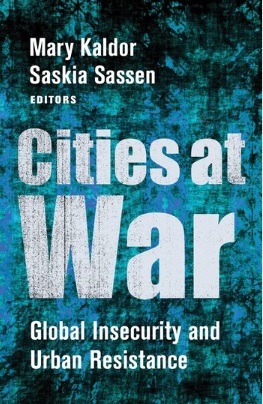This blog article was originally published by the Global Policy Journal.
Cities at War: Global Insecurity and Urban Resistance edited by Mary Kaldor and Saskia Sassen. New York: Columbia University Press, 2020. 264 pp., £74 hardcover 9780231185387, £25 paperback 9780231185394, £25 e-book 9780231546133

Mary Kaldor’s and Saskia Sassen’s new edited volume makes a rich contribution to the booming literature on urbanity in contexts of war and peace. Specifically, it looks at the ways in which ‘urban capabilities’ are mobilised to ensure urban survival in insecure conditions. The latter, as the book shows, stem from a variety of sources, including, war, intervention, ethnic divisions, criminal activities and structures of inequality. Cities, in a way, are read as places of extreme politics, where complex threats and responses to those emerge in dense clusters. The book thus emphasises the agency of urban dwellers to find creative means of ensuring the functioning of their everyday lives in the most adverse and difficult circumstances.
To illustrate those points, most of the chapters (all of which zoom in on a particular city) provide a ‘thick description’ of urban life. Based on in-depth field-based research, they take the reader on an imaginary journey into the lives and spaces of urban dwellers, and provide a lively description of the social and political dynamics of urban life. The reader can easily visualise the taxis, cafes, bunkers, ghettos and walls, and almost feel the urban ‘buzz’. Case studies include the cities of Bamako (by Ruben Andersson), Kabul (by Florian Weigand), Baghdad (by Ali Ali), Ciudad Juárez (by Mary Martin), Karachi (by Sobia Ahmad Kaker), Goma (by Karen Büscher), Bogotá (by Johannes Rieken, Efraín García-Sánchez and Daniel Bear) and Novi Pazar (by Vesna Bojicic-Dzelilovic).
What the composition of chapters is particularly successful in is the illustration of urban patterns that reach beyond the immediate locality of each individual city. Indeed, it becomes clear that similar geographies of intervention are at play in seemingly unconnected cities. The reader understands that there are power relations at play through which commonly used patterns of intervention create similar architectures and movement profiles in urban areas in different parts of the world. The rich urban stories provided in the book render such patterns evident. Therefore, although the cities analysed in this book are treated in separate chapters and not compared in the strictest sense, they jointly speak to a number of points:
CitiesFirst, hard security and human security are linked, albeit not in linear ways. Sometimes, the creation of militarised security infrastructures can impact adversely on the provision of human security if done in a way that is disconnected from the lived realities of the citizens, as the case study of Bamako aptly illustrates. In that context, the relationship between poverty and insecurity is problematised and implicitly reframed as a relationship between inequality and insecurity, which the chapters on Karachi, Novi Pazar, Bogotá and Ciudad Juárez aptly show. Second, as the chapters on Kabul, Karachi and Goma demonstrate, security is partly a matter of urban materiality, in the sense of infrastructures and access to facilities. However, the chapters also suggest that we must not neglect the role of perception either, as perceptions of insecurity have a profound knock-on effect on people’s daily movements and interactions. Third, it is important not to view the city as a static space, but instead to acknowledge processes of change and transformation. Urbanization (Goma), enclavization and ghettoization (Karachi, Bogotá) and mobility (Goma, Bogotá) reflect the ever-changing nature of urban landscapes. They also cast light on the fact that cities are constituted not just locally, but also nationally, regionally and globally (cf. Massey, 1991). Threats therefore emerge from both within and outside the immediate borders of the urban space.
 While investigating the complex nature of urban insecurity, the book also includes stories about urban resilience and capabilities. Vesna Bojicic-Dzelilovic’s outline of the case of Novi Pazar is a particular point in case here in highlighting the long-standing, yet frail, urban tradition of resisting ethnic lines of division in a highly contested political environment. This speaks to Florian Weigand’s finding from Afghanistan, where the author suggests that the residents of Farza District have, somewhat in contrast to Kabul, managed to establish a security structure that is grounded in the community and responsive to local needs.
While investigating the complex nature of urban insecurity, the book also includes stories about urban resilience and capabilities. Vesna Bojicic-Dzelilovic’s outline of the case of Novi Pazar is a particular point in case here in highlighting the long-standing, yet frail, urban tradition of resisting ethnic lines of division in a highly contested political environment. This speaks to Florian Weigand’s finding from Afghanistan, where the author suggests that the residents of Farza District have, somewhat in contrast to Kabul, managed to establish a security structure that is grounded in the community and responsive to local needs.
The urban stories included in this book therefore cover a diversity of experiences and speak to a wide range of geographical contexts. I would suggest that the ambition to adopt a post-colonial focus (page 4) may be an overstatement though. A post-colonial approach would have benefitted from a more nuanced analysis of the extent to which urban space is, or can be, a colonised space, in terms of how it has been created and structured through historical structures of domination and oppression. One could even go as far as to argue that the distinction between rural and urban spaces can be read as a false dichotomy, not unrelated to colonial structures. In this context, it would have been interesting to problematise further the link between poverty and violence, which some of the chapters indeed do. Perhaps, in this light, the book’s focus on “cities that are not considered part of the advanced industrial world” (page 19) could be challenged in an acknowledgement that post-colonial exclusions and peripheries can also be found in the geographic North (cf. de Sousa Santos, 2016), and that urban insecurities are not only a territorial question, but equally one of resource distribution and networks of exclusion more generally.
Having said that, this book is a highly valuable resource for scholars in the fields of Urban Studies as well as Security, War and Peace Studies. The richness of the empirical material, the individual chapters that speak to each other so well and the insights into patterns of urbanity provide excellent inputs into discussions of power, resistance, inequality and violence. Urban life may be about finding ways to survive under insecure conditions (page 231), but it is also about dignity, solidarity and creative ways of living together. This edited volume provides nuanced insights into what such urban capabilities mean for different cities and their inhabitants. Eventually, such discussions may lead to tentative conclusions of what solidarities beyond the immediate urban borders may mean for a globalised search for peace and security, grounded in locally articulated needs and resistant to violence, in whichever form the latter manifests itself in urban life.
References
De Sousa Santos, Boaventura (2016), “Epistemologies of the South and the future”, From The European South 1: 17-29.
Massey, Doreen (1991), “A global sense of place”, Marxism Today (38) 24-29.
Note: The CRP blogs gives the views of the author, not the position of the Conflict Research Programme, the London School of Economics and Political Science, or the UK Government.




